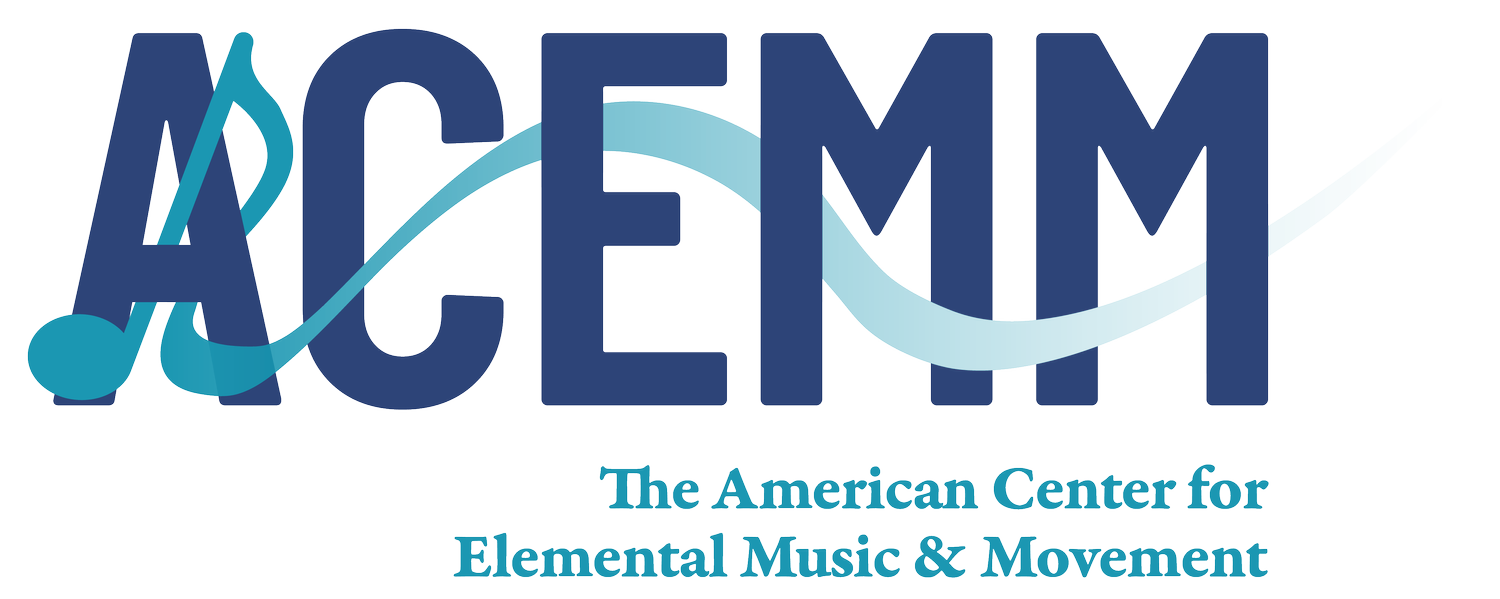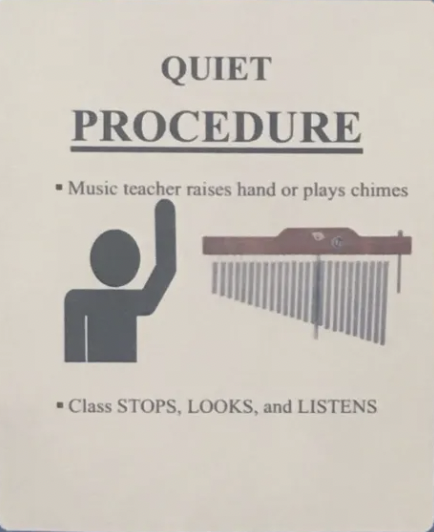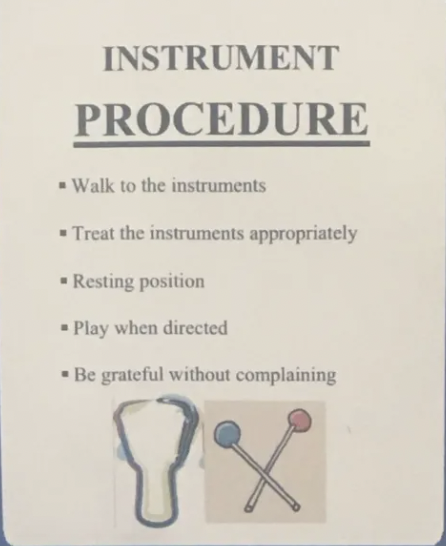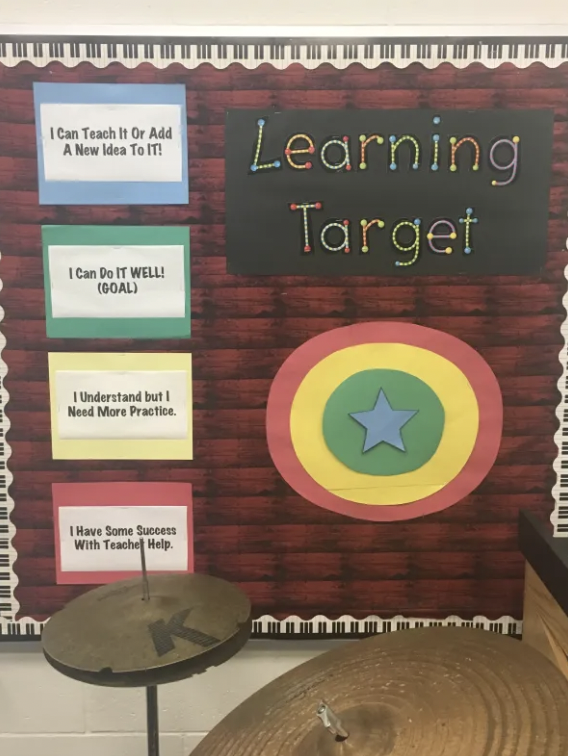Mindfulness in the Classroom – How Not to Lose Your Mind!
By Laura Stack
ACEMM Spotlight Award Recipient, Summer, 2014
“Joey hit me.”
“I have to go the bathroom.”
“I never get a turn!”
*A child taps on a xylophone while the teacher gives directions*
Teaching music can bring so much joy to our hearts. Truly. Let’s be honest, however. There are some days when the choir of tattletales and disruptions can get the best of us. Without utilizing mindfulness in the classroom, it is easy to get caught up in the challenges of our craft. We spend the day putting out fires and can forget why it is we do what we do.
The opposite of being in that state of distraction is mindfulness. Mindfulness is being fully present in the moment, focused on where we are and what we are doing. Letting energy and attention be caught up by wandering thoughts and distractions can produce a feeling of being overwhelmed and a level of stress that is unhelpful in dealing with what is going on around us. Though mindfulness is often associated with meditative moments, it can also be a state of relaxed readiness that helps produce clear, unreactive thinking – very useful in the daily stresses of teaching and re-acting to a myriad of unpredictable events.
Music teachers are particularly vulnerable to the lack of mindfulness, simplybecause there is so much going on in a classroom where movement, talking and extraneous noise-making are part of the creative process. By achieving more mindfulness in the classroom, music teachers can enjoy more of the sounds that make our souls sing.
“I’ve got it!”
“You can be my partner.”
“This is awesome!”
*Children giggle in pure delight while learning a folk dance*
Using the Behavior Management Cycle can provide a structure for reaching that state of mindfulness. The Behavior Management Cycle is a method of managing behavior using 3 simple steps. This system was developed by the Academy of Urban School Leadership in Chicago and used in classrooms around the country. There are many great management systems available. Ultimately, each teacher must decide how to best utilize his/her unique talents and personality. I have used the Behavior Management Cycle in 100% poverty, urban schools for the past 6 years. It works for me. Most days. You may already have a system in place that works for you. Likely, we pick and choose parts of behavior management systems that fit our strengths. Ultimately this will lead to your own unique approach that is true for you. Kids respond to authenticity. If you do not have a system in place, I encourage you to try out the Behavior Management Cycle so you have a starting point for gaining more control, peace, and joy in your classroom.
Take a look at the following benefits of utilizing the Behavior Management Cycle in the classroom:
More time for play and less time spent on behavior disruptions
Positive environment, conducive to making music
Calm teacher who is less likely to engage in negative interactions
Students notice that on task behavior is highly regarded
Students are motivated to follow directions
Sound good? Yes! Follow 3 simple steps in the Behavior Management Cycle to bring this magic to your classroom. Here is an easy way to remember it: BMC = GNC.
Behavior Give clear directions
Management Narrate positive behavior
Cycle Consequences
THE BEHAVIOR MANAGEMENT CYCLE (BMC)
Give clear directions
Narrate positive behavior
Provide Consequences
BMC STEP #1: GIVE CLEAR DIRECTIONS
Physical movement (Tell the students what to do with their bodies.)
Verbal expectation (Tell the students the voice level expectation.)
Participation in the activity (Tell the students how to participate in the activity.)
Check for understanding (Ask students to repeat the directions.)
Cue to start (Say “Go.” This is a great way to playfully catch students that start moving before you say go. I always ask with a smile, “Did I say go?” They usually freeze in their tracks and look up at you in joyful anticipation of the go signal.)
A template for giving clear directions sounds like this….
When I say go, move to the ________ at a voice level ______.
When you get there, ___________.
What do you do when I say go? (Call on a student to repeat the directions)
Ready? Go.
Or…Want to get your kids to the xylophones? Here is how it may sound:
When I say go, move to the xylophones at a voice level 0. When you get there,
place your mallets in resting position.
What do you do when I say go? (Call on a student to repeat the directions)
Ready? Go.
Ready to practice? Choose one of the following scenarios from your classroom to practice.
BMC PRACTICE SCENARIOS:
Entrance/dismissal
Quiet signal after a disruption
Small groups create an ostinato
RISERS: Line up by height and go on/off the risers
Put away supplies
Get to the xylophones from the carpet
Play the drums
Find a partner
Teach a folk dance
Make a circle
**** anything else that tends to lead to chaos********
Note! My school uses voice levels to specifically describe the volume expectation for students’ voices. Try incorporating voice levels into your directions.
VOICE LEVELS
0 = Silent
1 = Whisper
2 = Small Group
3 = Presentation Voice
4 = Outside Voice
Example of clear directions using voice levels:
When I say go, find a partner at a voice level 1. When you find your partner, sit down together and face the front. If you need a partner, raise your hand.
What do you do when I say go? (Call on a student to repeat the directions)
What do you do if you are still looking for a partner? (Call on a student)
Ready? Go.
BMC STEP #2: NARRATE POSITIVE BEHAVIOR
Look for students complying
Narrate positive behavior
Use within 2 seconds of directions
Use before corrective action
Continue every 60 seconds (more or less depending on class/activity)
A template for narrating positive behavior may sound like this….
I see_______ moving at a voice level 0.
The back row is setting a great example by _________.
______ is being a leader by_______.
Wow! This is what professional musicians look like when they are__________.
Well done front row!
Let’s practice step #2. Choose another practice scenario below and imagine what the students would be doing. Act as if you just gave the directions.
BMC PRACTICE SCENARIOS
Entrance/dismissal
Quiet signal after a disruption
Small groups create an ostinato
RISERS: Line up by height and go on/off the risers
Put away supplies
Get to the xylophones from the carpet
Play the drums
Find a partner
Teach a folk dance
Make a circle
**** anything else that tends to lead to chaos********
Now, look for the first child doing something right and speak to the behavior. It’s amazing what happens when you focus your attention on what is going well. Oh, life lessons! Even in the midst of chaos, there is at least one child following the directions. Notice that child. Give a compliment before immediately turning your attention to students that are off task. I try to narrate at least 3 behaviors that are on task before jumping to consequences.
Example statements, noticing behaviors that are on task:
I see Andrea moving at a voice level 0.
The back row is setting a great example by keeping their hands in their lap and their eyes on me.
Titus is being a leader by putting away his hand drum without playing it.
Wow! This is what professional musicians look like when they are in ready position. Well done front row!
BMC STEP #3: CONSEQUENCES
Use within 10-20 seconds of giving directions
Restate directions and provide consequence as a choice
Consequences should come from a Discipline Hierarchy
Example of a Discipline Hierarchy
Warning
1st time-out in class
2nd time-out out of class (In a different classroom. I partner with the art teacher and we have students take their 2nd time-out in one another’s classrooms. It works wonders!)
Phone call home
Discipline referral to the office
Take corrective action every time students are disruptive
Catch students being on task
Move-in / Move-out if needed
Use professional judgment for out-of-the norm behavior
Be prepared for students to test your limits…
Stay calm
Use broken record technique (simply repeat directions)
Do not engage
Have a backup plan (example: call the office for assistance)
The following lists are ideas on how to administer a variety of consequences…
MS. STACK’S CONSEQUENCES SENTENCE STARTERS…
There are 10 students with their hands raised, we need the whole class.
I see two students running and the expectation is to walk.
Is there a reason that you are not participating?
_________ , this is your warning for talking.
You can move to your seat or go to the cool down corner.
_________, do you need to take a break?
_________, rule number four is to raise your hand.
Take 3 minutes in the cool down corner then you get to come right back.
I’m going to set the timer for 1 minute. If you are not in the cool down corner by the time it goes off, I will need to call the office. I would like you to stay and be a part of our class. (Then walk away before you lose your mind.)
I’m going to set the timer for 3 minutes. When you get to the cool down corner, it will start. The sooner you get there, the sooner you can come back. (Then turn your attention away from the child and keep teaching.)
MS. STACK’S PRIVATE CONFERENCE WITH A STUDENT SENTENCE STARTERS
_________, is everything okay today?
Is there anything going on that I should know about?
_________, you are a leader and we need your help.
It seems like you’re having a tough time today. How can I help you?
I’m sorry I was short with you. Let’s work on this together.
Remember what we talked about last week. Are you ready to have a good day today? You can do it.
MS. STACK’S POST TIME-OUT SENTENCES STARTERS
Are you ready to come back and make better choices?
I care about you.
I have bad days too. It’s okay. I forgive you. Let’s try again.
OTHER TIPS & TRICKS:
Apps: iDoceo
Website: Class Dojo
Rules posted and referenced often
Cool Down Corner / Time-out desk in a corner of your room
Treasure Box (reward a student for going above and beyond to help, sing a solo, bring in an item from home that connects with the curriculum, etc.)
Positive Office Awards (write an award for a student who demonstrated the school character traits: Example: A student shows responsibility by wrapping up all of the headphones without being asked)
Humor
Monthly Free Choice Activity (for students that did not sit out that month)
iPads/SMARTBoard/Engaging technology
Quiet breathing break
Nonthreatening class meeting (sit the class in a circle and ask students to share why they think the class is having trouble following directions and what they can come up with as a group to help class go better)
Keyboards free play
Short motivational clips (ex: Kid President)
Song of the Month (pop song kids like)
Let your personality shine as a teacher
Have fun!
Love the children
Ultimately, the 3 simple steps of the Behavior Management Cycle can help to simplify your approach to managing behavior and put the joy back in making music!
Try it! BMC = GNC! Go get it!






